
Rareplanes 1/72 L-5 Sentinel
| KIT #: | ? |
| PRICE: | $ |
| DECALS: | No options |
| REVIEWER: | Carmel J. Attard |
| NOTES: | Basic Vacuform kit |

| HISTORY |
The US
light aircraft L-5 Sentinel began life as the pre-war Stinson model 105. The
model 105 was nicknamed Voyager, built by the Stinson division of Consolidated
Vultee. When
the war broke out, the Voyager was redesigned and then
entered into service as a liaison aircraft. It also flew in the artillery
spotter role and as an air ambulance. The later model L-5s had their fusalages
modified to accommodate one stretcher patient.
The L-5 was
manufactured between October 1942 and September 1945, during which time a total
of over 3,896 of these unarmed, two-seat aircraft were built for the United
States armed forces, making it the second most widely used light observation
aircraft of
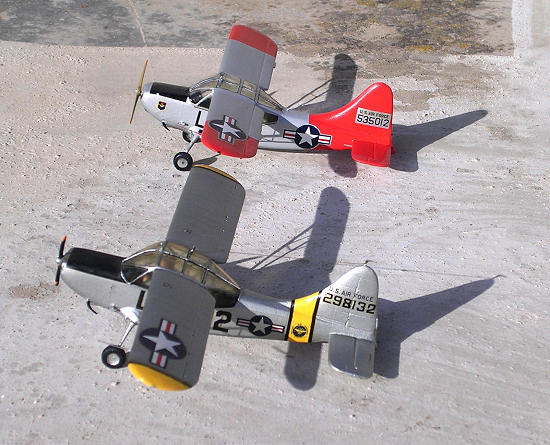 the war.
Personnel in all service branches commonly referred to it as the "Flying Jeep".
The L-5 was capeable of operating from forward unimproved airstrips for
delivering information and needed supplies to the front line troops. On the
return trip, she would evacuate the badly wounded soldiers to rear area field
hospitals for medical attention
the war.
Personnel in all service branches commonly referred to it as the "Flying Jeep".
The L-5 was capeable of operating from forward unimproved airstrips for
delivering information and needed supplies to the front line troops. On the
return trip, she would evacuate the badly wounded soldiers to rear area field
hospitals for medical attention
The L-5 was
primarily constructed from steel tubing and plywood and was covered with doped
cotton fabric.
The L-5 Sentinel carried a variety
of colourschemes and markings. Standard camouflage
as delivered from the factory was non-specular medium gray undersides with olive
drab above, broken around the edges of the wing and tail surfaces with medium
green. Stars, or "stars and bars" were applied to both sides of the fuselage and
on the upper left and lower right wingtips. The USAAF number appeared on both
sides of the fuselage in either yellow or black. Most aircraft were repainted
silver during the post-WWII period. A variety of unit identification markings
including nose art were applied in the field. Interior surfaces were generally
finished in chromate green or a slightly darker "interior green".
After WWII
the L-5 was widely used by the Civil Air Patrol for search and rescue work.
Today there are about 300 known examples left world wide and less than half are
in flying condition. A restored, flying example of the OY-1 variant (VH-NOY) is
located in Coolangatta, Queensland, Australia. This example was built for the
USAAF but was finally supplied to the US Navy serving until 1949.
A group called the Sentinel Owners and Pilots Association is dedicated to the
preservation and enjoyment of this aircraft type.
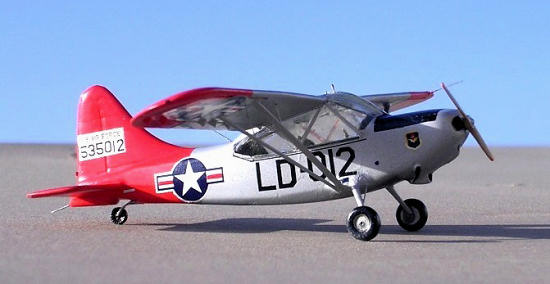 Five
versions were produced for the U.S. Army Air Force (USAAF); the L-5, L-5B, L-5C,
L-5E and L-5G. There was no L-5A variant as is often reported. The L-5 carried a
pilot and observer in a tandem seating
configuration. The L-5B through L-5G models were modified to carry a litter
patient or light cargo, or a rear seat passenger sitting in the normal position.
The Navy and Marine versions of the airplane were the OY-1 and OY-2. The latter
differed from all others in that it had a 24 volt electrical system instead of
the standard 12 volts. The British procured 40 L-5s, known as Sentinel Is, and
60 L-5Bs known as Sentinel IIs. The various designations of Sentinels with
respect to their mission or equipment was as follows:
Five
versions were produced for the U.S. Army Air Force (USAAF); the L-5, L-5B, L-5C,
L-5E and L-5G. There was no L-5A variant as is often reported. The L-5 carried a
pilot and observer in a tandem seating
configuration. The L-5B through L-5G models were modified to carry a litter
patient or light cargo, or a rear seat passenger sitting in the normal position.
The Navy and Marine versions of the airplane were the OY-1 and OY-2. The latter
differed from all others in that it had a 24 volt electrical system instead of
the standard 12 volts. The British procured 40 L-5s, known as Sentinel Is, and
60 L-5Bs known as Sentinel IIs. The various designations of Sentinels with
respect to their mission or equipment was as follows:
O-62 Sentinel :Observation, artillery spotting and liaison aircraft, powered by
a Lycoming 0-431-5-1 piston engine. 275 built.
L-5 Sentinel: Observation, artillery spotting and liaison aircraft. 1,456 built.
L-5A Sentinel: 688 L-5s were fitted with a revised electrical system.
L-5B Sentinel: 679 aircraft with modified rear fuselage to permit loading of a
stretcher.
L-5C Sentinel: 200 aircraft were equipped with a reconnaissance camera.
L-5E Sentinel: 558 aircraft were equipped with ailerons that drooped with flap
extensions.
L-5G Sentinel: Similar to the L-5E, powered by a 142-kW (190-hp) Lycoming
0-431-11 piston engine. 115 built.
XL-5 Sentinel: One test and evaluation aircraft, powered by a Lycoming 0-436-2
piston engine.
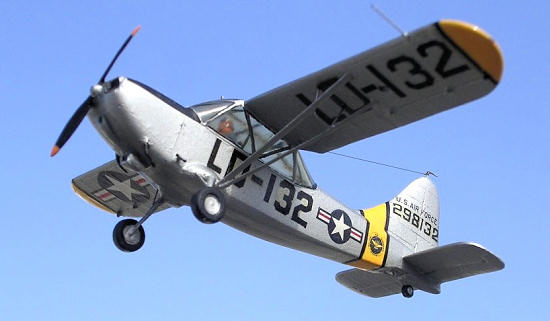 U-19A
Sentinel: All surviving L-5 Sentinels were redesignated U-19A by the USAF in
1962.
U-19A
Sentinel: All surviving L-5 Sentinels were redesignated U-19A by the USAF in
1962.
U-19B Sentinel: One L-5 Sentinel was being used as a glider tug at the US Air
Force Academy.
OY-1 Sentinel: 306 L-5s were supplied to the US Marine Corps and 152 to the US
Navy
OY-2 Sentinel: 30 OY-1s with only minor equipment changes.
Sentinel Mk I: 40 L-5s were supplied to the RAF under Lend-Lease
Sentinel Mk II: 60 L-5Bs were supplied to the RAF under Lend-Lease.
| THE KIT |
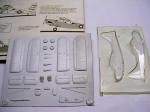 This
is a pretty basic kit. Supplied in a stapeled polytene bag the kit consists of
one sheet of white plastic with all vacform components on it and another clear
acetate sheet containing the complete fuselage halves. A 2 page A4 size
instruction sheet contains enough information, including four side views of the
L5 for
colour finish suggestions, both in WWII and Post war
service and a 4 view scale drawing of the Sentinel. There is a clear exploded
view which assists with the assembly of all the kit parts once these have been
sanded down to the required shape.
This
is a pretty basic kit. Supplied in a stapeled polytene bag the kit consists of
one sheet of white plastic with all vacform components on it and another clear
acetate sheet containing the complete fuselage halves. A 2 page A4 size
instruction sheet contains enough information, including four side views of the
L5 for
colour finish suggestions, both in WWII and Post war
service and a 4 view scale drawing of the Sentinel. There is a clear exploded
view which assists with the assembly of all the kit parts once these have been
sanded down to the required shape.
| CONSTRUCTION |
Once more we are dealing with another vacform kit which
incorporates a delicate but enjoyable preparation of kit parts before these can
be assembled. This is a standard procedure where each moulded kit part are first
trimmed from the backing sheet with a sharp knife or just score around with a
blade, breaking away excess plastic with fingrs. The edges of all cmponents are
then rubbed
on a flat sheet of wet and dry sand-paper. In doing so we
remove just enough plastic, aproximately ½ a millimeter to ensure that
centreline joints are perfect. Water can be used while the abrasive action is
carried out but since this is not a resin kit I
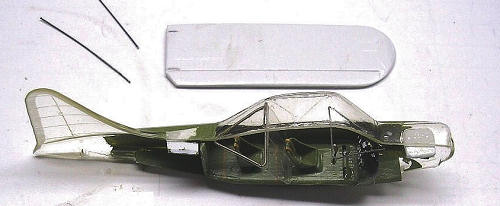 did away
with water. In the case of resin I use water as a safety precaution to prevent
particle from being inhaled. The trailing edges of the wings are first scraped
with a sharp knife on the inside until a slim aerfoil shape is obtained on the
flying surfaces before attempting to cement the parts together.
did away
with water. In the case of resin I use water as a safety precaution to prevent
particle from being inhaled. The trailing edges of the wings are first scraped
with a sharp knife on the inside until a slim aerfoil shape is obtained on the
flying surfaces before attempting to cement the parts together.
The acetate fuselage halves were dealt in same manner as
the other parts on white plastic with the exception of masking the window clear
areas to prevent any risk of scratching. Whereas Humbrol liquid cement is ideal
to join together the plastic pieces, in the case of acetate I used Superglue on
the outside perifery to avoid any clouding effect forming to the enclosure of
the canopy. Before assembly, fuselage interior details were added. These include
two crew seats with straps, control column, rudder pedals, coaming and
instruments and the triangular tube structures at the front and rear inside the
cockpit which were made out of stretch sprue and fitted inside as per sketch in
the instructions. I also inserted two parallel metal pins across the upper deck
which will assist to locate the wings at their roots to the fuselage. There is
also a transparent partition which separated the front seat from the one at the
rear. The wing struts were cut from strips of plastic while the mid strut
support were shaped in the form of a ‘U’ out of a thin steel pin. The port wing
antenna and the rear antenna were also made of steel wire. Undercarriage legs,
and rear wheel oleo were also fashioned out of steel wire. A metal propeller was
obtained from the cottage industry
market.
I have made two models of the Sentinel and both were post war type, a U-19A and a U-19B. The former was attached to the USAF MATS squadrons used as a hack and rescue aircraft. This had the antenna similar to the type that existed on WWII L-5s, and the U-19B which had glider tail tug for use to train aircrew on gliders. This had a whip antenna aft of the canopy.
| COLORS & MARKINGS |
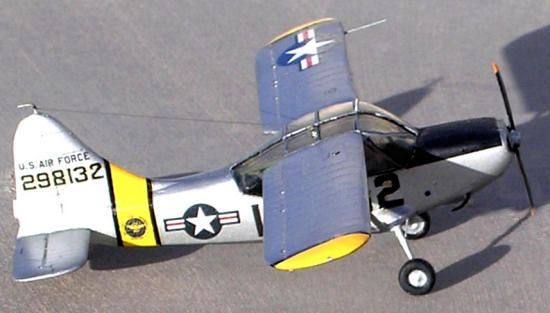 Both
aircraft were predominantly silver and in the case of the U-19A this carried ID
yellow bands with a black outline to fuselage and wing tips with black
Bu-number. The U-19B carried high visibility red/orange areas to rear fuselage
and wing outer halves. The Humbrol silver had a few drops of white added to the
latter type as it appeared to be anodized on the colour print that I was
referring to. As for the bright red/orange I have used Model Master Italian red.
The interior were painted cockpit green in both kits including a rear bulkhead,
while the seats were leather brown with pale yellow straps. Instruments were
white on a black panel. US insignia and Bu-Numbers came from various sheets of
Super Scale decal and the MATS crest on the U-19A came from a spare S-55 Airfix
decal sheet. Both models were given a coat of Johnsons Clear before putting on
the decals. The anti glare panel and foot step patch at the base of the wing
struts were gloss black with matt varnish added on.
Both
aircraft were predominantly silver and in the case of the U-19A this carried ID
yellow bands with a black outline to fuselage and wing tips with black
Bu-number. The U-19B carried high visibility red/orange areas to rear fuselage
and wing outer halves. The Humbrol silver had a few drops of white added to the
latter type as it appeared to be anodized on the colour print that I was
referring to. As for the bright red/orange I have used Model Master Italian red.
The interior were painted cockpit green in both kits including a rear bulkhead,
while the seats were leather brown with pale yellow straps. Instruments were
white on a black panel. US insignia and Bu-Numbers came from various sheets of
Super Scale decal and the MATS crest on the U-19A came from a spare S-55 Airfix
decal sheet. Both models were given a coat of Johnsons Clear before putting on
the decals. The anti glare panel and foot step patch at the base of the wing
struts were gloss black with matt varnish added on.
| CONCLUSIONS |
As the Rareplane kits are showing their age, the clear perspex had a hue of
yellow but this was not excessive. As you can probably gather this is a pretty
ordinary kit but still the surface detail present did not spoil the look and
certain areas like the absence of trim tabs t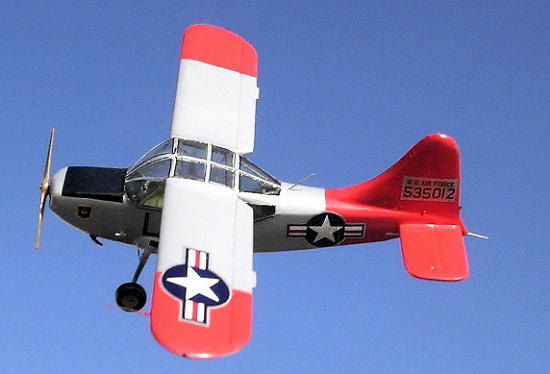 o
the ailerons and rudder, these were added and also sharpened up some areas to
bring out the salient features of the Sentinel. The kits were worth taking time
over and when completed they both looked quite spectacular in a not so familiar
but lively markings.
o
the ailerons and rudder, these were added and also sharpened up some areas to
bring out the salient features of the Sentinel. The kits were worth taking time
over and when completed they both looked quite spectacular in a not so familiar
but lively markings.
| REFERENCES |
Scale Aircraft Modeller
Wickipedia encyclopedia
Aviation News.
If you would like your product reviewed fairly and quickly, please contact the editor or see other details in the Note to Contributors.